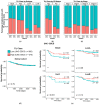Spatial Characterization of Tumor-Infiltrating Lymphocytes and Breast Cancer Progression
- PMID: 35565277
- PMCID: PMC9105398
- DOI: 10.3390/cancers14092148
Spatial Characterization of Tumor-Infiltrating Lymphocytes and Breast Cancer Progression
Abstract
Tumor-infiltrating lymphocytes (TILs) have been established as a robust prognostic biomarker in breast cancer, with emerging utility in predicting treatment response in the adjuvant and neoadjuvant settings. In this study, the role of TILs in predicting overall survival and progression-free interval was evaluated in two independent cohorts of breast cancer from the Cancer Genome Atlas (TCGA BRCA) and the Carolina Breast Cancer Study (UNC CBCS). We utilized machine learning and computer vision algorithms to characterize TIL infiltrates in digital whole-slide images (WSIs) of breast cancer stained with hematoxylin and eosin (H&E). Multiple parameters were used to characterize the global abundance and spatial features of TIL infiltrates. Univariate and multivariate analyses show that large aggregates of peritumoral and intratumoral TILs (forests) were associated with longer survival, whereas the absence of intratumoral TILs (deserts) is associated with increased risk of recurrence. Patients with two or more high-risk spatial features were associated with significantly shorter progression-free interval (PFI). This study demonstrates the practical utility of Pathomics in evaluating the clinical significance of the abundance and spatial patterns of distribution of TIL infiltrates as important biomarkers in breast cancer.
Keywords: TILs; breast cancer; computational pathology; machine learning; risk of recurrence.
Conflict of interest statement
The University of North Carolina, Chapel Hill has a license of intellectual property interest in GeneCentric Diagnostics and BioClassifier, LLC, which may be used in this study. The University of North Carolina, Chapel Hill may benefit from this interest that is/are related to this research. The terms of this arrangement have been reviewed and approved by the University of North Carolina, Chapel Hill Conflict of Interest Program in accordance with its conflict-of-interest policies.
Figures






Similar articles
-
Pathomics Image Analysis of Tumor Infiltrating Lymphocytes (TILs) in Colon Cancer.Res Sq [Preprint]. 2025 Apr 1:rs.3.rs-6173056. doi: 10.21203/rs.3.rs-6173056/v1. Res Sq. 2025. PMID: 40235501 Free PMC article. Preprint.
-
Deep-Learning-Based Characterization of Tumor-Infiltrating Lymphocytes in Breast Cancers From Histopathology Images and Multiomics Data.JCO Clin Cancer Inform. 2020 May;4:480-490. doi: 10.1200/CCI.19.00126. JCO Clin Cancer Inform. 2020. PMID: 32453636 Free PMC article.
-
Theragnostic significance of tumor-infiltrating lymphocytes and Ki67 in BRAFV600-mutant metastatic melanoma (BRIM-3 trial).Curr Probl Cancer. 2022 Jun;46(3):100862. doi: 10.1016/j.currproblcancer.2022.100862. Epub 2022 Apr 2. Curr Probl Cancer. 2022. PMID: 35398635 Clinical Trial.
-
Pitfalls in machine learning-based assessment of tumor-infiltrating lymphocytes in breast cancer: A report of the International Immuno-Oncology Biomarker Working Group on Breast Cancer.J Pathol. 2023 Aug;260(5):498-513. doi: 10.1002/path.6155. Epub 2023 Aug 23. J Pathol. 2023. PMID: 37608772 Free PMC article. Review.
-
The journey of tumor-infiltrating lymphocytes as a biomarker in breast cancer: clinical utility in an era of checkpoint inhibition.Ann Oncol. 2021 Oct;32(10):1236-1244. doi: 10.1016/j.annonc.2021.07.007. Epub 2021 Jul 24. Ann Oncol. 2021. PMID: 34311075 Review.
Cited by
-
Spatial proximity of CD8+ T cells to tumor cells predicts neoadjuvant therapy efficacy in breast cancer.NPJ Breast Cancer. 2025 Feb 10;11(1):13. doi: 10.1038/s41523-025-00728-9. NPJ Breast Cancer. 2025. PMID: 39929822 Free PMC article.
-
Interaction between redox regulation, immune activation, and response to treatment in HER2+ breast cancer.Redox Biol. 2025 May;82:103609. doi: 10.1016/j.redox.2025.103609. Epub 2025 Mar 22. Redox Biol. 2025. PMID: 40174475 Free PMC article. Review.
-
Open and reusable deep learning for pathology with WSInfer and QuPath.NPJ Precis Oncol. 2024 Jan 10;8(1):9. doi: 10.1038/s41698-024-00499-9. NPJ Precis Oncol. 2024. PMID: 38200147 Free PMC article.
-
Artificial Intelligence-Powered Whole-Slide Image Analyzer Reveals a Distinctive Distribution of Tumor-Infiltrating Lymphocytes in Neuroendocrine Neoplasms.Diagnostics (Basel). 2022 Sep 27;12(10):2340. doi: 10.3390/diagnostics12102340. Diagnostics (Basel). 2022. PMID: 36292028 Free PMC article.
-
Predicting early breast cancer recurrence from histopathological images in the Carolina Breast Cancer Study.NPJ Breast Cancer. 2023 Nov 11;9(1):92. doi: 10.1038/s41523-023-00597-0. NPJ Breast Cancer. 2023. PMID: 37952058 Free PMC article.
References
-
- Virchow R. Die krankhaften Geschwülste; Dreissig Vorlesungen: Gehalten Während des Wintersemesters. Volume 2. Universität zu Berlin; Berlin, Germany: 1862. p. 1865.
-
- Ehrlich P. Experimentelle Studien an Mausetumoren. Z Krebsforsch. 1907;5:59–81. doi: 10.1007/BF02015526. - DOI
Grants and funding
LinkOut - more resources
Full Text Sources

